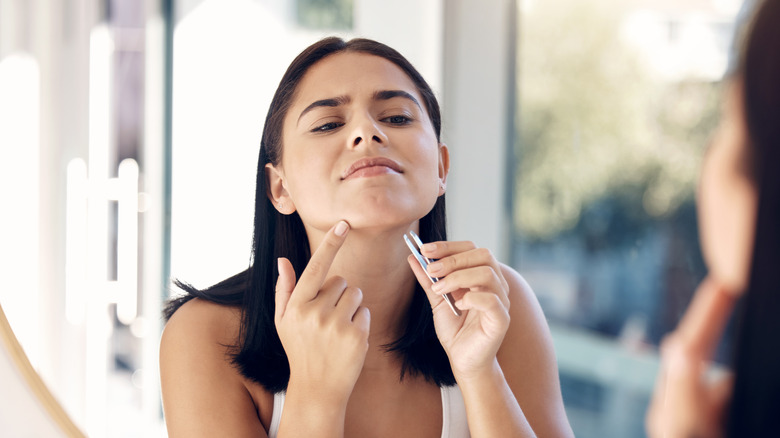Dermaplaning Hair Regrowth Isn't As Scary As It Sounds - Here's The Deal
If you've always wanted a buttery soft, super smooth face but steered clear of shaving off the peach fuzz getting in the way, dermaplaning may convince you to finally join the facial hair-free club. Dermaplaning is a method of exfoliation that removes the top layers of skin, taking baby hairs along with them. During the procedure, a doctor or cosmetologist uses a bladed tool to carefully shave your face, leaving you with a silky complexion that may absorb skincare products more effectively (meaning your creams and serums will be even more potent) and take makeup better (no more foundation clinging to the fuzz on your cheeks!).
According to Cleveland Clinic, risks associated with the in-office procedure are minimal. At worst, you could suffer from a skin infection, scarring, or skin discoloration. You may also notice irritation if you have acne, eczema, psoriasis, rashes, or any other skin inflammation or injury. Generally, though, dermaplaning is considered to be a safe, minimally invasive way to renew the look and texture of your face.
However, there's one question that often comes to mind among dermaplaning newbies: What happens when the hair grows back? Well, you'll most likely go to touch your face, and the hair may appear a bit thicker, seeing as the hair is growing back. Luckily, it doesn't stay that way.
Hair won't grow back thicker or darker
In 2022, influencer and "Love Island" star Molly-Mae Hague made headlines after explaining in a YouTube video that dermaplaning gave her a "full beard" when her facial hair started growing back. However, experts say this isn't possible and the notion that hair grows back thicker or darker is just a myth. "A surgical blade is used, which just shaves the ends from the fine vellus hairs. Nothing happens to the follicles themselves, so the growth of the hair isn't changed," Dr. David Jack, an aesthetic doctor, told PopSugar.
Still, post-dermaplaning regrowth can appear thicker than your previously untouched hair because the blade leaves a blunt edge, which may make stubble more noticeable at first, as per Mayo Clinic. It's also important to note that you'll have to tend to regrowth more quickly than with some other types of hair removal. "Unlike waxing, dermaplaning does not fully remove hair from its follicle, so hairs might grow back a bit sooner than other methods," Mehmet Göker, dermatology specialist at Turkey's Vera Clinic shared with Metro. "Although there is no scientific study that confirm hairs grow back thicker and faster, the results can be different per skin type."
How to deal with hair regrowth after dermaplaning
Dermaplaning results aren't permanent, so if you want to maintain your baby-soft skin, you'll need to repeat the procedure regularly to keep stubble at bay. Dermatologist Dr. Melissa Doft told Cosmopolitan that it's best to space out appointments by at least one month to give your skin time to recover, and those with sensitive skin should wait even longer. In other words, aim for one session per season, she says.
The method requires a professional, so if stubble is really getting you down before it's time for your next appointment, you can shave at home yourself. Use a fresh, single-blade razor designed for the face, and work in short strokes, going in the direction of hair growth. Follow up with a moisturizer to protect and rehydrate the skin.
If you decide to stick with your natural fuzz and ditch dermaplaning altogether, be patient as your hair grows back. Any prickliness you may notice at first will subside over time as hair softens and returns to its full length, according to Oregon Plastic Surgeons.


